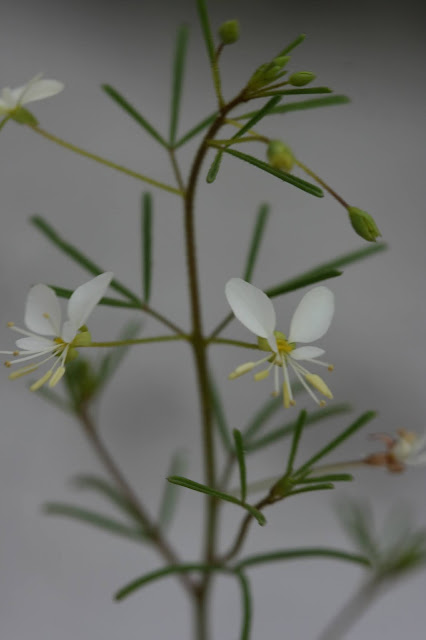 |
| Flowers |
 |
| Flower Close Up |
 |
| Stems |
Goldenrods (
Solidago spp.) are often difficult for the average wildflower enthusiast to identify to species. Their bright golden flowers are dead giveaways to bring you to the genus level, but after that it can get confusing. This could be the case for this one, Carolina goldenrod (
S. arguta var.
caroliniensis) without a close look at its foliage and the arrangement of its flowers during its summer bloom time.
 |
| Lower leaf |
Two years ago, I was fortunate to purchase a couple of specimens from Marc Godts at Green Isles Nursery in the Groveland area of central Florida and these photos come from the plants I added to my wildflower garden. This species has been vouchered in most Florida counties in the northern third of the state. This variety also is widespread throughout the states of the Southeast - from Missouri and Louisiana to Maryland south along the Atlantic coast. Other varieties of this species occur as far west as Texas, through much of the Midwest and throughout the Eastern Seaboard, including populations in Quebec. Yet, despite its extensive range, very little seems to have been written about it. It is not mentioned in any of the Florida wildflower books that I own, for example.
It is reported that it occurs mostly in areas of woodland openings, such as outcrops or clearings. In my landscape, it has not been fussy about growing conditions. I have them planted in average, Florida sandy soil in full sun. It is a perennial, like other members of this genus, and dies back to the ground in winter. In spring, it forms a basal rosette of rather large oval leaves that are slightly toothed. These tend to die back, however, as the flower stalks extend in early summer. Eventually, the plants reach about 3 feet in height. The leaves and the stems are slightly "hairy" and the upper leaves along the stems become smaller and more elliptical. The ones in these photographs are about 1 inch in length. Often, the stems are somewhat reddish as well.
Flowering occurs in mid-summer, before most of the other goldenrods bloom in my landscape. A great many open panicles form at the top of the main stem and small heads of about 20 flowers occur along each side stem. This aspect, as shown in these photos above, is diagnostic for any of Florida's native goldenrods that I've encountered - or grown. The flowers are a more-lemon yellow color than most others as well.
Like other members of this genus, the blooms are especially attractive to pollinating insects. It is a wonder to me that more species are not routinely available from native nurseries here in Florida and I feel fortunate that Marc chose to propagate a few that year. Many goldenrods make poor additions to a mixed wildflower garden because they sucker extensively and I have been looking for and propagating/growing as many as I can find in order to"weed out" those aggressive species. So far, Carolina goldenrod has played well with its neighbors in my landscape. It is easy to propagate from seed and I hope to add it to the plants I offer next spring at Hawthorn Hill.
 |
| Lower Stem |

































